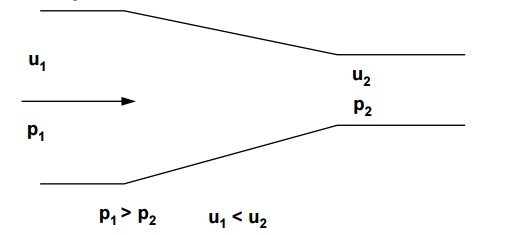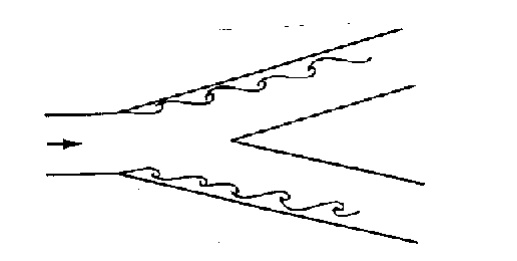Chapter: Civil : Mechanics Of Fluids : Boundary Layer
Mechanics Of Fluidsr: Boundary layer separation

Boundary layer separation
(i)
Convergent flows: Negative pressure gradients
If flow over a boundary occurs when there is a pressure decrease
in the direction of flow, the fluid will accelerate and the boundary layer will
become thinner.
This is the case for
convergent flows.

The accelerating fluid maintains the fluid close to the wall in
motion. Hence the flow remains stable and turbulence reduces. Boundary layer
separation does not occur.
(ii) Divergent flows:
Positive pressure gradients
When the pressure increases in
the direction of flow the situation is very different. Fluid outside
theboundary layer has enough momentum to overcome this pressure which is trying
to push it backwards. The fluid within the boundary layer has so little
momentum that it will very quickly be brought to rest,and possibly reversed in
direction. If this reversal occurs it lifts the boundary layer away from the
surfaceas shown below.

This phenomenon is known as boundary layer separation.
At the edge of the separated
boundary layer, where the velocities change direction, a line of vortices occur
(known as a vortex sheet). This happens because fluid to either side is moving
in the opposite direction.

This boundary layer separation and increase in the turbulence
because of the vortices results in very large energy losses in the flow.
These separating / divergent flows are inherently unstable and far
more energy is lost than in parallel or convergent flow.
(iii) A divergent duct
or diffuser
The increasing area of flow
causes a velocity drop (according to continuity) and hence a pressure
rise(according to the Bernoulli equation).

Increasing the angle of the
diffuser increases the probability of boundary layer separation. In a Venturi
meter it has been found that an angle of about 6 o provides the optimum balance between length of meter and danger
of boundary layer separation which would cause unacceptable pressure energy
losses.
(iv) Tee-Junctions

Assuming equal sized pipes, as fluid is removed, the velocities at
2 and 3 are smaller than at 1, the entrance to the tee. Thus the pressure at 2
and 3 are higher than at 1. These two adverse pressure gradients can cause the
two separations shown in the diagram above.
(v) Y-Junctions
Tee junctions are special cases
of the Y-junction with similar separation zones occurring. See the diagram
below.

Downstream, away from the
junction, the boundary layer reattaches and normal flow occurs i.e. the effect
of the boundary layer separation is only local. Nevertheless fluid downstream
of the junction will have lost energy.
Related Topics